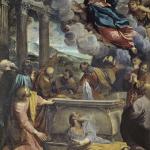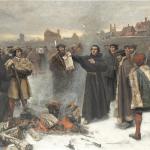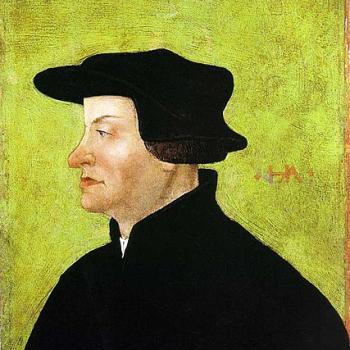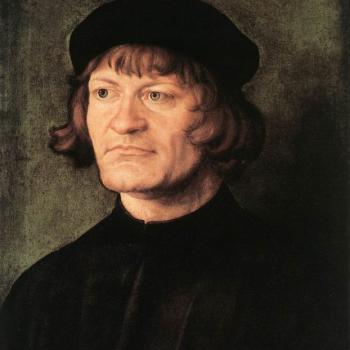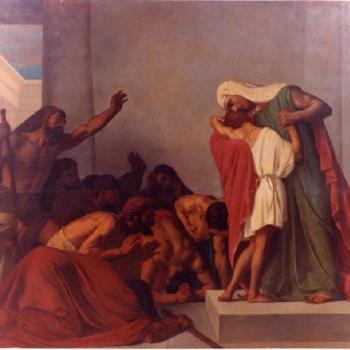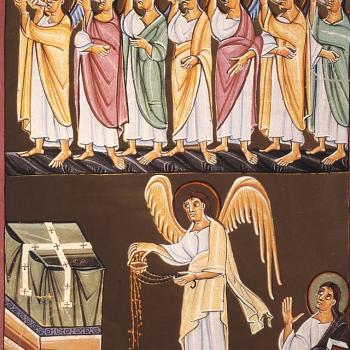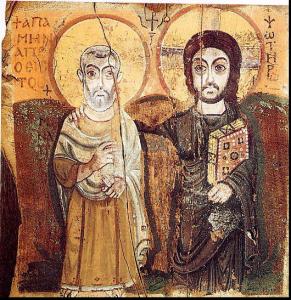
“Please Hit ‘Subscribe’”! If you have received benefit from this or any of my other 4,600+ articles, please follow this blog by signing up (with your email address) on the sidebar to the right (you may have to scroll down a bit), above where there is an icon bar, “Sign Me Up!”: to receive notice when I post a new blog article. This is the equivalent of subscribing to a YouTube channel. Please also consider following me on Twitter / X and purchasing one or more of my 55 books. All of this helps me get more exposure, and (however little!) more income for my full-time apologetics work. Thanks so much and happy reading!
Johann Eck (1486-1543) was a German Catholic theologian, who was arguably one of Martin Luther’s two most important and formidable debate opponents, along with Erasmus (I’ve compiled several of his devastating replies to Luther as well). He was ordained as a priest in 1508 and in 1510 was installed as a professor of theology at the University of Ingolstadt in Bavaria: which lasted for thirty years. He mastered both Greek and Hebrew and had a prodigious memory, boundless energy, and very considerable debating skills. He famously engaged Luther for eighteen days in the Leipzig Disputation of July 1519.
Eck’s argumentation might be said to be one of the quintessential examples of the Catholic theological and polemical response to the Protestant Revolt up to the opening of the Council of Trent in 1545. This is one of many excerpts from his best-known and principal volume, Enchiridion of Commonplaces Against Luther and Other Enemies of the Church. It first appeared in 1529 and eventually went through 91 editions. I will be using a later edition from 1541 (translated by Ford Lewis Battles, Grand Rapids, Michigan: Baker Book House, 1979; now in the public domain).
Eck’s words will be in black and my interjections in blue. I use RSV for scriptural citations.
***
Although the Jewish nation was somewhat inclined to idolatry, still God commanded them to have some images.
“You shall make also two cherubim of beaten gold on the two sides of the oracle. Let one cherub be on the one side and the other on the other” [Ex 25:18].
“The Lord said to Moses: Make a brazen serpent, and set it up for a sign” [Num 21:8].
[Objection] “You shall not make for yourselves any idol or graven thing, neither shall you erect pillars, nor set up a remarkable stone in your land, to adore it” [Lev 26:1; RSV: “to bow down to them”]. . . . “You shall not make a graven image or a likenness of anything which is in heaven above, on the earth below, or of those things which are in the waters under the earth” [Ex 20:4]. Something similar is said in Ex 34:17; Dt 4:23; 5:8; 27:15, and in many other passages of the Old Testament.
[Reply] By what preceded and what follows God explains his intention, for just as he forbade strange gods to be worshiped, so he forbade images of them, yet because we do not take our saints for gods, we are not forbidden to make images of them. For before the quoted words, he says: “You shall not have strange gods before me,” “You shall not make for yourself anything graven,” etc. There follows: “You shall not adore them, or worship them.” Note: they ought not to be carried to that extreme. So does Luther himself understand this.
But if Leo Jud of Zurich is tied to the letter in the Jewish manner, saying that it is absolutely forbidden to make images, the corollary would be that Solomon sinned, when he made twelve little lions in his throne; he would have sinned by carving oxen in the brazen sea, and lions; and oxen and cherubim in the brazen basins [2 Ch 9; 1 K 7]. Who is so stupid as to believe that there was no painter, no sculptor in Judah, who then carved the cherubim? And if the use of such things among the Gentiles seems similar to our own, still they are far differently used; they use them to another end.
[Objection] Hezekiah broke the brazen serpent which Moses had made [2 K 18:4].
[Reply] That Hezekiah destroyed the serpent was caused by this abuse of the idolatrous people. For in the same passage there follows: “For till that time the children of Israel burnt incense to it” [2 K 18:4]. Hence, if it were a question of the abuse of any image, that ought to be abolished; therefore he withdrew the serpent, not because there was an image, but because the Jews were worshiping it.
[Objection] Christ promised that the time is coming and now is when true worshipers worship God in spirit and in truth [Jn 4:23]. But the Spirit is not influenced by images.
[Reply] We say that God is to be worshiped especially in spirit and in truth. Images admonish and remind us to do this. For that the spirit does not exclude sensible signs, the sacraments, which have been established in sensible signs, furnish us proof.
[Objection] Furthermore, the peril of idolatry lurks under images, and the danger of unclean thoughts as well.
[Reply] There is no danger of incurring idolatry, for the simpleminded can most easily be instructed to rectify their intention, considering that they are to refer their veneration not to the image itself, but to the prototype . . .
[Objection] Balthasar Hubmaier makes this horned argument: Either images have been commanded, and then Scripture is shown forth, or they have not been commanded, and then are not valid.
[Reply] It is clear from the first and second and fourth points, how truly horned is this argument . . . This is not commanded in Scripture, therefore it is not to be observed. On the contrary, by this horn let us accuse him: is there anything commanded in Scripture, which is nevertheless not to be observed, as for example, on the hallowing of the Sabbath, on not eating blood or strangled animals, etc.? . . . I shall say: to celebrate the Lord’s Day to him is either a commandment and is set forth by Scripture, or is not a commandment, and is consequently invalid— something even the heretic will not say!
***
*
Practical Matters: Perhaps some of my 4,600+ free online articles (the most comprehensive “one-stop” Catholic apologetics site) or fifty-five books have helped you (by God’s grace) to decide to become Catholic or to return to the Church, or better understand some doctrines and why we believe them.
Or you may believe my work is worthy to support for the purpose of apologetics and evangelism in general. If so, please seriously consider a much-needed financial contribution. I’m always in need of more funds: especially monthly support. “The laborer is worthy of his wages” (1 Tim 5:18, NKJV). 1 December 2021 was my 20th anniversary as a full-time Catholic apologist, and February 2022 marked the 25th anniversary of my blog.
PayPal donations are the easiest: just send to my email address: [email protected]. Here’s also a second page to get to PayPal. You’ll see the term “Catholic Used Book Service”, which is my old side-business. To learn about the different methods of contributing (including Zelle), see my page: About Catholic Apologist Dave Armstrong / Donation Information. Thanks a million from the bottom of my heart!
*
***
*
Photo credit: Christ and Saint Mina. 6th-century icon from Bawit, Egypt [public domain / Wikimedia Commons]
Summary: One of a series of posts documenting the Catholic apologetics efforts of Johann Eck (1486-1543) against Protestantism. This entry addresses veneration of images.


